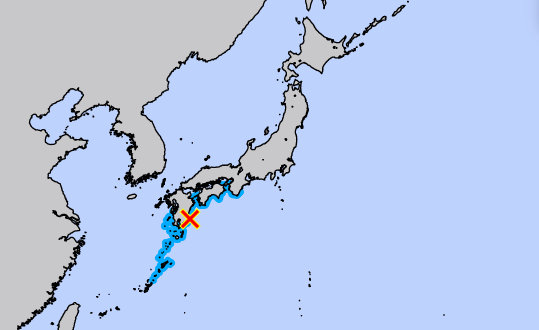Japan Meteorological Agency (JMA) on Thursday issued its first-ever alert warning about a possible megaquake around the Nankai Trough. JMA issued the warning following a a magnitude 7.1 quake that struck earlier in the day off the coast of Kyushu.
Also read; Boeing ramps up production of critical Patriot air defence missiles component
The quake occurred at around 4:43 pm local time (07:43 GMT) off the coast of the Miyazaki prefecture of Kyushu, at a depth of about 18 miles, triggering tsunami advisories, the JMA said.
It is believed that the chance of a major earthquake occurring in the Nankai Trough is relatively higher than usual, according to the agency.
However, it added that this does not mean an earthquake will necessarily occur within a specific timeframe.
An megaquake is loosely defined as an earthquake of exceptional destructive power, especially one with a magnitude of 8 or greater, which may generate a tsunami.
Following the 7.1 magnitude earthquake, Seismologists held an emergency meeting to analyze whether the quake had impacted the nearby Nankai Trough, where it has long been feared that a massive earthquake could cause hundreds of thousands of deaths.
It is believed that the chance of a major earthquake occurring in the Nankai Trough is relatively higher than usual, according to the agency, but it added that this does not mean an earthquake will necessarily occur within a specific timeframe.
The warning is expected to be in place for a week, but officials said residents should not let their guard down even after it is lifted.
Information from the agency on Nankai Trough megaquakes is delivered at two levels — an alert and a higher warning. The weather agency issued the lower level alert on Thursday, urging people to be prepared for cases requiring evacuation. No evacuations are required for the alert level.
Large earthquakes have taken place every 100 to 150 years in central and western parts of Japan.
According to Japan Forward, the government predicts a megaquake at the Nankai Trough within the next 30 years with 70-80% probability.
From a seismological perspective, the probability of a large quake in the Nankai Trough has become several times higher, the agency said. Such quakes happen roughly once every 100 years, but the exact timing cannot be predicted. The most recent one took place on Dec. 21, 1946, which was measured between 8.1 and 8.4 on the moment magnitude scale.
Japan’s Nuclear Regulation Authority confirmed that all 12 nuclear reactors on Kyushu and Shikoku islands are safe.
The massive 9.0-magnitude earthquake and subsequent tsunami that struck Japan in March 2011 left 18,000 dead and triggered the Fukushima nuclear disaster.
Japan sits on the ‘Ring of Fire,’ a line of seismic faults encircling the Pacific Ocean, and is one of the world’s most earthquake-prone countries.
More than 240 people died and tens of thousands of homes were destroyed in January, when a 7.6-magnitude tremor hit the Noto peninsula in the western part of the country.
In the event of a major earthquake in the Nankai Trough, intense shaking is expected over a wide area from the Kanto region to Kyushu, and high tsunami waves are anticipated along the Pacific coast from the Kanto region to Okinawa, JMA said in a statement.
If an earthquake with a magnitude of 9.0 struck in the Nankai Trough, the shaking in the Kanto region could be around a lower or upper 5 on the Japanese seismic intensity scale, similar to the tremors the region experienced during the Great East Japan Earthquake in 2011.
Large quakes in the Nankai Trough have historically caused severe damage, originating from the plate boundary region stretching from Suruga Bay to offshore Hyuganada, according to the Cabinet Office.
According to the government’s damage assessments published in 2012, a tsunami caused by a Nankai Trough megaquake could result in up to 224,000 deaths, which can be reduced by roughly 80% with sufficient evacuation efforts immediately after the earthquake.
Nnamdi Maduakor is a Writer, Investor and Entrepreneur
